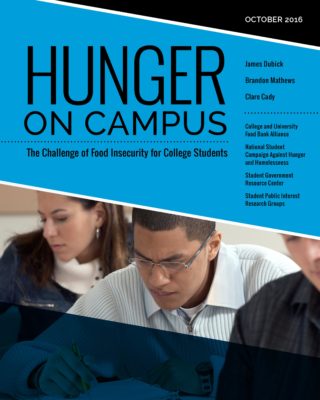 Hunger On Campus
Hunger On Campus
The Challenge of Food Insecurity for College Students
October 2016
Executive Summary
Food insecurity – the lack of reliable access to sufficient quantities of affordable, nutritious food – is common at colleges and universities across the country, potentially undermining the educational success of untold thousands of students.
Given its potential impact, the collective understanding of this issue is still far too limited. The existing studies on campus food insecurity have almost exclusively looked at individual colleges and university systems or focused on community colleges.
In order to expand the understanding of campus food insecurity, the coordinators of this report set out to implement the broadest study on this issue to date by surveying students across a wide range of regions and school types. In doing so, the goal was to foster a more expansive understanding of campus food insecurity and its impact on students, while also bringing national attention to this critical issue.
Four campus-based organizations – the College and University Food Bank Alliance, the National Student Campaign Against Hunger and Homelessness, the Student Government Resource Center, and the Student Public Interest Research Groups – surveyed college students on food insecurity between March and May 2016. The study sample includes 3,765 students in 12 states attending eight community colleges and 26 four-year colleges and universities. The sample was assembled using in-person recruitment, and represents about 0.5% of the students attending those 34 institutions.
Findings include:
- Consistent with prior studies, 48 percent of respondents reported food insecurity in the previous 30 days, including 22 percent with very low levels of food security that qualify them as hungry.
- Food insecurity occurs at both two-year and four-year institutions. Twenty-five percent of community college students qualified as having very low food security, compared to 20 percent at four-year schools.
- Food insecurity was more prevalent among students of color. Fully 57 percent of Black or African American students reported food insecurity, compared to 40 percent of non-Hispanic white students.
- More than half of all first-generation students (56 percent) were food insecure, compared to 45 percent of students who had at least one parent who attended college.
The study also took a close look at the approximately 1,800 students who reported experiencing food insecurity in order to better understand their experiences.
Students experiencing food insecurity often also suffer from housing insecurity, such as difficulty paying the rent, mortgage, or utility bills.
- Sixty-four percent of food insecure students reported experiencing some type of housing insecurity.
- Fifteen percent of food insecure students reported experiencing some form of homelessness – the most extreme form of housing insecurity – in the past 12 months.
- Housing insecurity is greater at community colleges, where 13 percent of all respondents (regardless of food insecurity) experienced homelessness, compared to seven percent at four-year schools.
Problems with food or housing harm students’ educational efforts. Of the food insecure students in the study, 32 percent believed that hunger or housing problems had an impact on their education. These students reported a range of consequences:
- Fifty-five percent reported that these problems caused them to not buy a required textbook;
- Fifty-three percent reported missing a class; and
- Twenty-five percent reported dropping a class.
Food insecurity is a problem even for students who are employed, participate in a campus meal plan, or seek other financial or material help.
- Fifty-six percent of food insecure students reported having a paying job. Of those employed students, 38 percent worked 20 hours or more per week.
- Being enrolled in a meal plan with a campus dining hall does not eliminate the threat of food insecurity. Among the respondents from four-year colleges, 43 percent of meal plan enrollees still experienced food insecurity.
- Three in four food insecure students received some form of financial aid. More than half (52 percent) received Pell Grants and 37 percent took out student loans during the current academic year.
- Sixty-one percent of food insecure students reported that their household had utilized at least one existing aid service in the past 12 months. Twenty-five percent reported using the Supplemental Nutrition Assistance Program (SNAP, formerly known as food stamps), making it the most widely used food program.
These findings reinforce the growing understanding that food insecurity presents a serious challenge for today’s college students, and highlight the need for additional research to better understand this problem and explore effective solutions.
School leaders and policymakers can take a number of steps to help lessen student food insecurity and reduce its threat to educational quality and student success.
- Colleges should pursue a wide range of creative ways to address food insecurity, including the creation of campus food pantries, campus community gardens, food recovery programs, and coordinated benefits access programs.
- More significantly, policymakers should take steps to improve students’ access to existing federal programs, including expanding the SNAP eligibility requirements for college students, simplifying the FAFSA process (particularly for homeless students), and adding food security measurements to the annual National Postsecondary Student Aid Study.